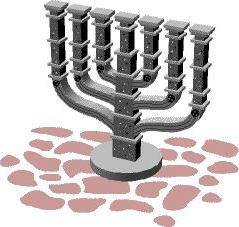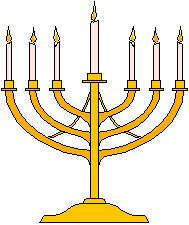Menorah
 From the time the ancient Israelites wandered in the desert of Sinai, the seven-branched lampstand (menorah means "lampstand") has symbolized their connection to God. The Torah tells us that the first menorah was created by the artisan Bezalel, whom God endowed with divine skills, and he built the first lampstand for the wilderness tabernacle in which the Israelites offered sacrifices to God. When Solomon built a Temple in Jerusalem, the menorah was transferred to it. In the year 70 C.E., the Roman general Titus destroyed the Second Temple and brought the menorah to Rome as a trophy of war. The Arch of Titus, built to commemorate this victory, depicts the menorah being carried from Jerusalem to Rome. The motif of the menorah began to appear in other locations at this time, including carved into sarcophagi and tombstones, and in the tiled designs of synagogue walls and floors.
From the time the ancient Israelites wandered in the desert of Sinai, the seven-branched lampstand (menorah means "lampstand") has symbolized their connection to God. The Torah tells us that the first menorah was created by the artisan Bezalel, whom God endowed with divine skills, and he built the first lampstand for the wilderness tabernacle in which the Israelites offered sacrifices to God. When Solomon built a Temple in Jerusalem, the menorah was transferred to it. In the year 70 C.E., the Roman general Titus destroyed the Second Temple and brought the menorah to Rome as a trophy of war. The Arch of Titus, built to commemorate this victory, depicts the menorah being carried from Jerusalem to Rome. The motif of the menorah began to appear in other locations at this time, including carved into sarcophagi and tombstones, and in the tiled designs of synagogue walls and floors.
The classical menorah is shaped much like a tree, with a central shaft reaching from the ground heavenward, and possessing three branches on either side. The number seven reflects Creation, itself, because the Torah teaches that the world was created in six days (the six branches) and God rested on the seventh day (the central shaft, just as Shabbat continues to be the central institution of Jewish life). Mystics connected the seven branches with the seven heavens. The tree-like shape of the menorah has been associated with the "Tree of Life."
The chanukiyyah -- special menorah designed for use on Chanukah -- is modeled on the classical Jewish menorah. It, too, has a central shaft and the central shaft supports eight branches, designated to represent the eight nights of Chanukah. The central shaft is known as the "shammas" (server) for its candel is used to light the others. While many people refer to the nine-branched lampstand as a "menorah" it is more properly called a chanukiyyah.

More Rituals and Practices:
 From the time the ancient Israelites wandered in the desert of Sinai, the seven-branched lampstand (menorah means "lampstand") has symbolized their connection to God. The Torah tells us that the first menorah was created by the artisan Bezalel, whom God endowed with divine skills, and he built the first lampstand for the wilderness tabernacle in which the Israelites offered sacrifices to God. When Solomon built a Temple in Jerusalem, the menorah was transferred to it. In the year 70 C.E., the Roman general Titus destroyed the Second Temple and brought the menorah to Rome as a trophy of war. The Arch of Titus, built to commemorate this victory, depicts the menorah being carried from Jerusalem to Rome. The motif of the menorah began to appear in other locations at this time, including carved into sarcophagi and tombstones, and in the tiled designs of synagogue walls and floors.
From the time the ancient Israelites wandered in the desert of Sinai, the seven-branched lampstand (menorah means "lampstand") has symbolized their connection to God. The Torah tells us that the first menorah was created by the artisan Bezalel, whom God endowed with divine skills, and he built the first lampstand for the wilderness tabernacle in which the Israelites offered sacrifices to God. When Solomon built a Temple in Jerusalem, the menorah was transferred to it. In the year 70 C.E., the Roman general Titus destroyed the Second Temple and brought the menorah to Rome as a trophy of war. The Arch of Titus, built to commemorate this victory, depicts the menorah being carried from Jerusalem to Rome. The motif of the menorah began to appear in other locations at this time, including carved into sarcophagi and tombstones, and in the tiled designs of synagogue walls and floors.